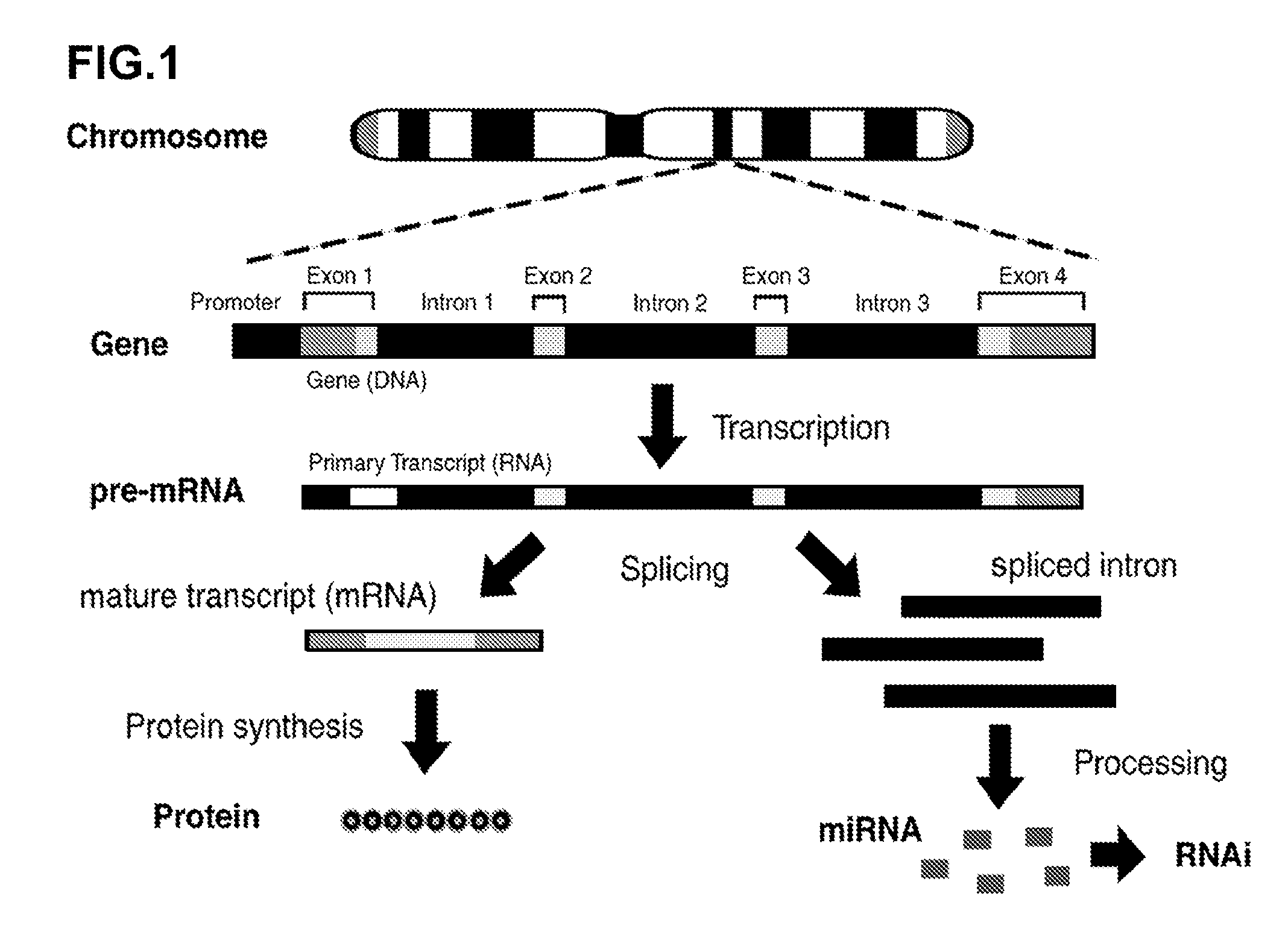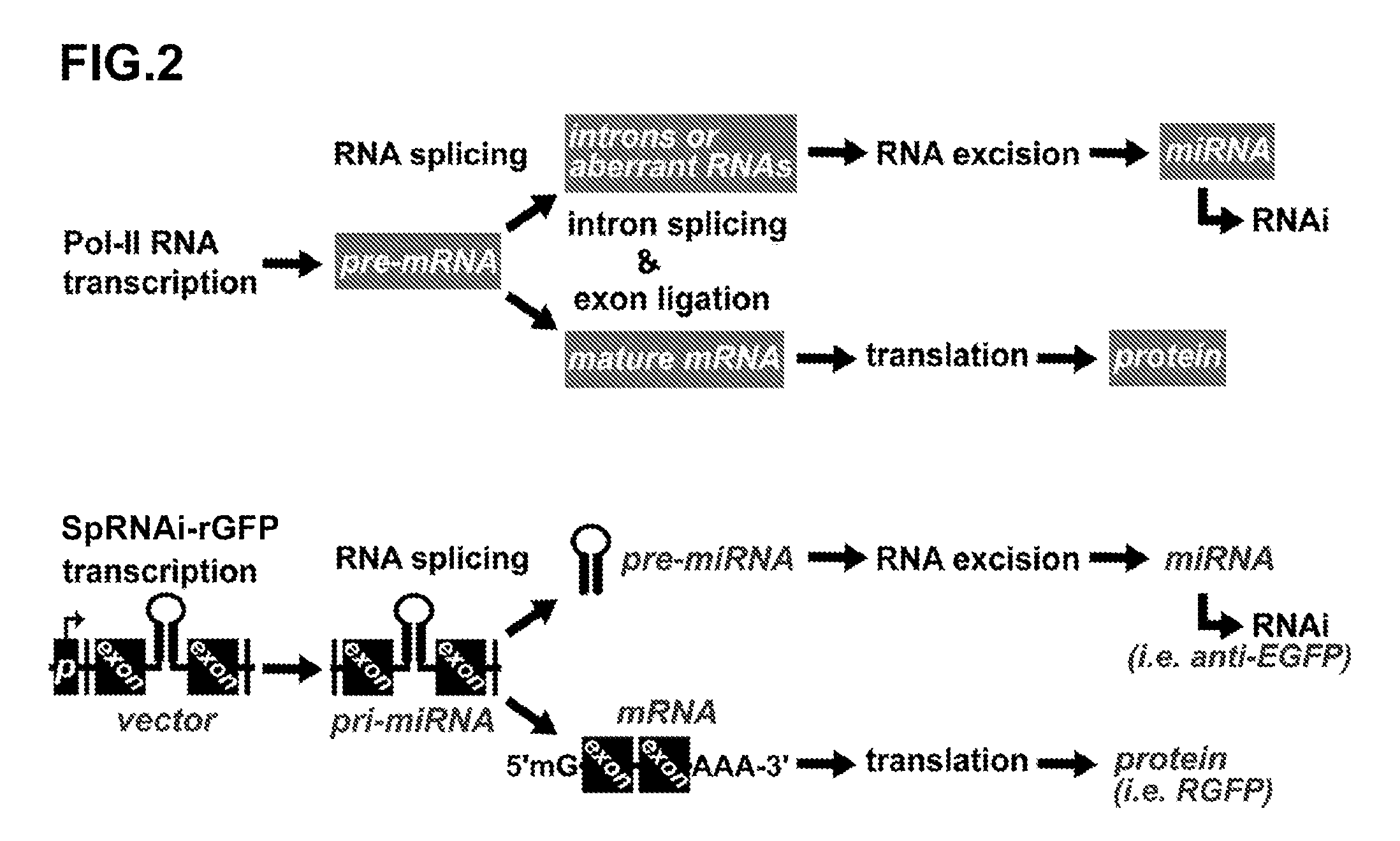Novel Transgenic Methods Using intronic RNA
- Summary
- Abstract
- Description
- Claims
- Application Information
AI Technical Summary
Benefits of technology
Problems solved by technology
Method used
Image
Examples
example 1
Cell Culture and Treatments
[0143] Rat neuronal stem cell clones AP31 and PZ5a were primary cultured and maintained as described by Palmer et. al., (J. Neuroscience, 1999). The cells were grown on polyornathine / laminin-coated dishes in DMEM / F-12 (1:1; high glucose) medium containing 1 mM L-glutamine supplemented with 1×N2 supplements (Gibco / BRL, Gaithersburg, Md.) and 20 ng / ml FGF-2 (Invitrogen, Carlsbad, Calif.), without serum at 37° C. under 5% CO2. For long-term primary cultures, 75% of the medium was replaced with new growth medium every 48 hr. Cultures were passaged at ˜80% confluency by exposing cells to trypsin-EDTA solution (Irvine Scientific) for 1 min and rinsing once with DMEM / F-12. Detached cells were replated at 1:10 dilution in fresh growth medium supplemented with 30% (v / v) conditioned medium which had exposed to cells for 24 hr before passaging. Human prostatic cancer LNCaP cells were obtained from the American Type Culture Collection (ATCC) and grown in RPMI 1640 me...
example 2
SpRNAi-Containing Recombinant Gene Construction
[0144] Synthetic nucleic acid sequences used for generation of three different SpRNAi introns containing either sense-, antisense- or hairpin-eGFP insert were listed as followings: N1-sense, 5′-pGTAAGAGGAT CCGATCGCAG GAGCGCACCA TCTTCTTCAA GA-3′ (SEQ.ID.NO.4); N1-antisense, 5′-pCGCGTCTTGA AGAAGATGGT GCGCTCCTGC GATCGGATCC TCTTAC-3′ (SEQ.ID.NO.5); N2-sense, 5′-pGTAAGAGGAT CCGATCGCTT GAAGAAGATG GTGCGCTCCT GA-3′ (SEQ.ID.NO.6); N2-antisense, 5′-pCGCGTCAGGA GCGCACCATC TTCTTCAAGC GATCGGATCC TCTTAC-3′ (SEQ.ID.NO.7); N3-sense, 5′-pGTAAGAGGAT CCGATCGCAG GAGCGCACCA TCTTCTTCAA GTTAACTTGA AGAAGATGGT GCGCTCCTGA-3′ (SEQ.ID.NO.8); N3-antisense, 5′-pCGCGTCAGGA GCGCACCATC TTCTTCAAGT TAACTTGAAG AAGATGGTGC GCTCCTGCGA TCGGATCCTC TTAC-3′ (SEQ.ID.NO.9); N4-sense, 5′-pCGCGTTACTA ACTGGTACCT CTTCTTTTTT TTTTTGATAT CCTGCAG-3′ (SEQ.ID.NO.10); N4-antisense, 5′-pGTCCTGCAGG ATATCAAAAA AAAAAGAAGA GGTACCAGTT AGTAA-3′ (SEQ.ID.NO.11). Additionally, two exon fragments were...
example 3
Vector Cloning of SpRNAi-Containing Genes
[0147] For cloning into plasmids, since the SpRNAi-recombinant rGFP gene possessed an XhoI and an XbaI restriction site at its 5′- and 3′-end, respectively, it can be easily cloned into a vector with relatively complementary ends to the XhoI and XbaI cloning sites. We mixed the SpRNAi-recombinant rGFP gene and the linearized 3,934-bp empty pHcRed1-N1 / 1 plasmid at 1:16 (w / w) ratio, cooled the mixture from 65° C. to 15° C. over a period of 50 min, and then added T4 ligase and relative buffer accordingly into the mixture for ligation at 12° C. for 12 hr. This formed an SpRNAi-recombinant rGFP-expressing plasmid (SpRNAi-rGFP) vector, which can be propagated in E. coli DH5a LB-culture containing 50 μg / ml kanamycin. A positive clone was confirmed by PCR reaction with rGFP-specific primers SEQ.ID.NO.13 and SEQ.ID.NO.14 at 94° C., 1 min and then 68° C., 2 min for 30 cycles, and further sequencing. For cloning into viral vectors, the same ligation pr...
PUM
| Property | Measurement | Unit |
|---|---|---|
| Fraction | aaaaa | aaaaa |
| Fraction | aaaaa | aaaaa |
| Fraction | aaaaa | aaaaa |
Abstract
Description
Claims
Application Information
 Login to View More
Login to View More - R&D
- Intellectual Property
- Life Sciences
- Materials
- Tech Scout
- Unparalleled Data Quality
- Higher Quality Content
- 60% Fewer Hallucinations
Browse by: Latest US Patents, China's latest patents, Technical Efficacy Thesaurus, Application Domain, Technology Topic, Popular Technical Reports.
© 2025 PatSnap. All rights reserved.Legal|Privacy policy|Modern Slavery Act Transparency Statement|Sitemap|About US| Contact US: help@patsnap.com



